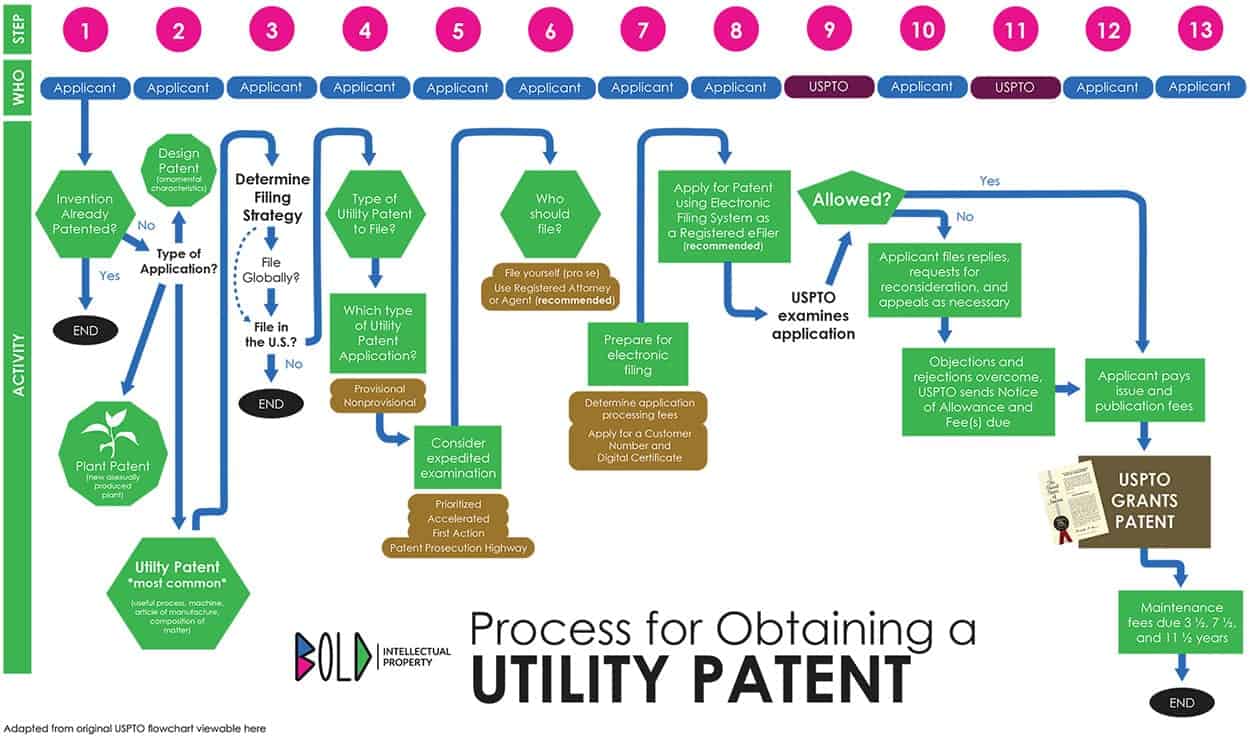If you want to ensure no one copies your invention or financially benefits from it, it’s time to apply for a utility patent. The utility patent timeline can vary depending on your invention, your record keeping, and your filing. For do-it-yourselfers, the process to obtain a patent typically takes around 25 months and there’s no guarantee that your application will be approved. However, a knowledgeable patent attorney can help you with this process, decreasing your stress, shortening the timeline, and improving your chances of approval. Whether you decide to do it yourself or partner with a patent attorney, there are things you should expect to encounter during the timeline of filing a utility patent.
Utility Patent Timeline
Before you start the utility patent application process it’s important to understand what you are trying to protect and in what area your invention falls. To qualify for a utility patent, your invention should fall into one of the following categories:
- Machines: a device that accomplishes a specific task
- Articles of Manufacture: a single object without movable parts like a pen or board
- Processes: provides a new way to obtain a result through a series of physical or chemical interactions
- Compositions: a combination of chemical an other matter like an element (made up of atoms), compound (made up of elements), or mixture (two or more substances)
- New Uses: changes the way in which a machine, article of manufacture, a process, or composition is used
While the utility patent timeline varies from inventor to inventor, according to the United States Patent and Trademark Office (USPTO), it typically takes about 25 months to get a patent approved. You can lessen that timeframe by ensuring your invention meets the below utility patent requirements:
- Your invention must fall within one of the above categories.
- Your invention must be useful.
- Your invention must be novel.
- Your invention must be nonobvious.
Some patents can take twice as long as others in a field with fewer patent applications. Make sure you follow the application process and be as detailed as possible when filling out the required paperwork.
No matter what your invention or how succinct your documents are, there are some things you can and should expect to encounter along the way. There are many factors that can impact your personal utility patent timeline.
What You Can Expect After Filing
Congratulations! You have filed your patent application, but what’s next? While you’re probably anxiously waiting to implement your go-to-market strategy, you shouldn’t rush the utility patent timeline. Putting the cart before the horse can be detrimental to the success of your product or service. Every patent application may start at the same place, but the path to conclusion differs from invention to invention. Why? Because the journey for each patent seeker is as unique as their invention.
Be mindful of the following after filing for a patent:
- What to file: You will need to determine if you want to file for a non-provisional patent or stick with the provisional patent. A provisional filing protects you for a year. While a provisional patent is less expensive and you can start making a profit once the patent is pending, the gain is short-lived. A non-provisional patent application extends your protection, but will cost more to file. However, a non-provisional patent allows you to benefit from 20 more years of financial gain.
- Patent pending: Your patent can be pending for months or a year. You are now playing the waiting game. This is why filing for a non-provisional patent may be best, so that you can still protect your idea while the patent examiner reviews your application.
- Patent examiner contact: The average pendency of a utility nonprovisional patent application to its approval is approximately two years. However, if you file for a request for continued examination (RCE), then you could be waiting up to four years. So the need to file an RCE adds almost 22 months to the average timeframe compared to an application without it.
- Office action response: You have three months to respond to a non-final Office Action without having to pay for an extension of time. However, the cost (and time needed) for responding to an Office Action will depend largely upon the nature of the rejections and the number of prior art references. Once an examiner has received your Office Action Response and it adequately addresses their concerns, they will make a determination as to whether to “allow” the patent to be issued and rights to be granted. If the examiner rejects your invention, another office action is sent and must be responded to with an Office Action Response.
- Notice of allowance: Approximately 18 months after filing your application, you should be notified whether or not it has been approved. Approximately 86% of patents are rejected each year. If you plan to accept a rejection, your timeline stops there. If you plan to appeal the rejection (patent prosecution), your utility patent timeline just increased exponentially.
Filing a utility patent application and getting approval can be complex and overwhelming. Your utility patent timeline depends on the complexity of your invention, how you file, what you file, and your response times. The USPTO implemented the Track One program, which strives to get to a final disposition (allowed or finally rejected) within 12 months. A knowledgeable patent attorney can help you determine if you qualify for this option or other special requests.
At Bold Patents, our experienced team of patent attorneys can help you navigate the utility patent timeline. While there is no way to guarantee a first-time approval for your utility patent, enlisting professional help improves your chances of success. To schedule a free Discovery Call with one of our Bold Attorneys, call 800-849-1913 or contact us.


